Camino de Santiago - French Way - Stage 1 - Saint Jean Pied-de-Port to Roncevalles
Total distance: 25 kilometres
Saint Jean Pied-de-Port is a French town situated on the banks of the River Nive at the foot of the Pyrenees mountain range approximately 8kms from the border with Spain. Dating back to Roman times this area has been an important passage through the Pyrenees and dating back to the 10th century it has been the meeting point of the Caminos de Santiago that come through from various points in France such as Paris, Vézelay and Le Puy.
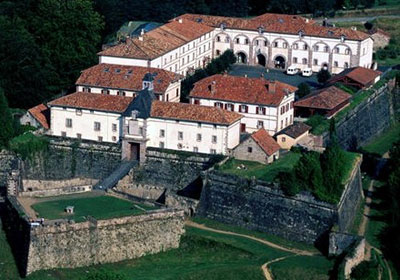
In the 12th century this part of the Pyrenees was part of the Spanish kingdom of Lower Navarra and the kings of Navarra rebuilt the town in the late 12th century after it had been destroyed by the British king Richard I, the Lionheart in 1177. Over the centuries the town's ownership changed numerous times between the French and Spanish as they fought for sovereignty over these lands. Finally during the French Revolution of 1789 to 1799 the Kingdom of Lower Navarra was abolished and has remained in French hands ever since.
During the late 15th and early 16th centuries, following the French Wars of Religion between French Catholics and Protestants, the town was fortified by Cardinal Richelieu who commissioned the building of the Citadel on a hill overlooking the town. The Citadel is now a college.
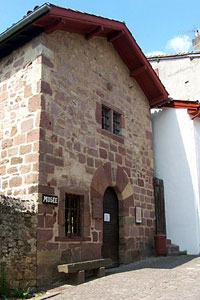
While you are here there are a couple of places worth visiting, most of which can be found off the cobbled street of Rue de la Citadelle where you will have picked up your credencial.
The first is the 13th century La prison dite des Evêques, or the Bishop's prison. Some claim that it had been the Bishop's residence but the local tourist office doesn't believe there was any link. It did however house those good for nothings that plagued the early pilgrims. The building now houses a museum on the Basque region as well as a museum on the Camino de Santiago.
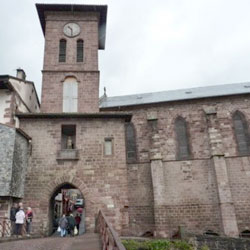
A little further down the street is the 14th century church Église de Nôtre Dame butting up against the imposing Porte de Nôtre Dame with its small statue of Santiago up above the arch. The current Gothic church was part of a former priory hospital and was built over the foundations of an earlier 13th century church that had been built by the Navarran King Sancho VII, el Fuerte. In front of the church is a fountain decorated in scallop shells.
Accommodation can be found in a number of different places mostly hostal but there are some more upmarket hotels. Most of the accommodation can be found along the Rue de la Citadelle or the Place du Général de Gaulle. You may have to reserve before you leave your country of origin as places are booked up a long time in advance, especially in busy periods.
To obtain your "credencial” or Pilgrim Passport make your way to Accuiel St Jacques at 39 Rue de la Citadelle, the main street through St Jean Pied-du-Port.
On your first proper day on the Camino de Santiago it is recommended that you leave early in the morning as most of the route is uphill and you don't want to be caught up in the mountains when the light is fading. Also make sure that you have a hearty breakfast and take enough food and drink with you to last the remainder of the day and to have something to eat for breakfast the following morning.
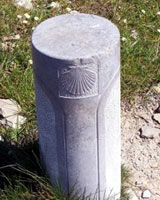
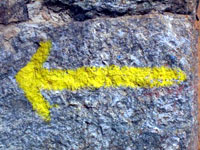
The Camino de Santiago is clearly marked by either yellow flashes, yellow arrows, red and white marks or marker stones with scallop shells. Here are just two examples.
Pilgrims usually depart on the Camino from the church Notre Dame du Bout du Port, continuing down le Rue d'Espagne towards the bridge over the River Nive, exiting the town walls through le Port d'Espagne.
Here the pilgrim is faced with a decision, do they take the route up over the Pyrenees or take the lower, mainly asphalted, route. The route over the mountains is known as the “Route de Napoléon” and the asphalted route (the D428 road, becoming the N135 when you enter Spain), taking you through the village of Valcarlos, is known as the "Chemin de Compostela".
The Chemin de Compostela is more suitable during the winter months as the mountains experience bad weather such as fog and snow. This route is also more suitable if you are doing the Camino by bike. A word of warning, if it is very windy down in St Jean Pied de Port then you must take the Chemin de Compostela. The Route de Napoléon is quite exposed the higher you get and you can encounter severe weather even in the middle of summer.

